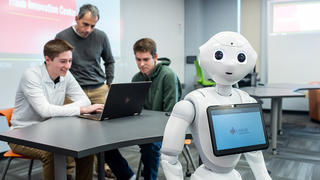Humanoid Robot Makes Hawk Hill Debut

Artificial intelligence is all around us, from our Zoom calls and car navigation systems to our social media feeds and digital assistants. Now, an artificially intelligent robot is helping students learn computer programming skills and greeting families on Saint Joseph’s campus.
Standing at just four feet tall, the fully programmable robot (whose factory name is Pepper) is capable of conversations, expressive movements and even recognizing human emotion. It’s a humanoid robot, meaning that its shape resembles that of a human, complete with an articulating torso, limbs, head and hands.
The bot arrived at Saint Joseph’s after Haub School of Business Dean Joseph A. DiAngelo Jr, EdD ’70 saw the robot at the Paris School of Business during an AACSB accreditation visit.
“It was impressive,” he says. “I knew Pepper would be a great way to promote our business school and give students the opportunity to engage in hands-on learning with artificial intelligence while having fun at the same time.”
Shipped less than a week before the University’s fall open house, the robot underwent a mini hackathon with graduate and undergraduate students, organized by Marcello Balduccini, PhD, assistant professor of decision and system sciences, and director of Haub Innovation Center.
“We had the program written and running ahead of time but from Tuesday through Sunday, we had to work on the finishing touches,” Balduccini says, “much of which included the physical movements and motions of the joints.”
The android comes with three different programming options to accommodate varying levels of expertise. The simplest option allows programmers to build a presentation that displays on the robot’s chest, which is accompanied by corresponding gestures. The other options include hard coding using a programming language like Python, and a middle-of-the-road option — selected by Balduccini and his students — which uses drag-and-drop functions to program movement, speech and the tablet.
“Artificial intelligence forces us to basically teach a computer how to solve problems in precise terms. It takes mental discipline and teaches students problem-solving skills.” - Marcello Balduccini, PhD, assistant professor of decision and system sciences, and director of Haub Innovation Center
“I was amazed by all that our team was able to accomplish in such a short amount of time. Many of us had programming experience, but nobody had worked on anything similar to the robot before. It was a real learning experience,” says Andrew Holmberg ’23.
The robot’s open house premiere was well received, during which it greeted and interacted with over 25 prospective students and their families.
“Artificial intelligence forces us to basically teach a computer how to solve problems in precise terms," says Balduccini. "It takes mental discipline and teaches students problem-solving skills.”
The humanoid robot isn’t the only futuristic technology housed in the Innovation Center; it also boasts home automation technology, including Google Home minis and WiFi-enabled outlets; Meta Quest virtual reality headsets; Ray Ban smart glasses and more.
“I was amazed by all that our team was able to accomplish in such a short amount of time. Many of us had programming experience, but nobody had worked on anything similar to the robot before. It was a real learning experience.” - Andrew Holmberg ’23, machine learning and artificial intelligence major
Balduccini plans to launch an initiative where students can submit proposals on how they’d like to leverage the Center’s technology. He’s also looking forward to further integrating the Center into workshops, classes and research opportunities.
“I see the physical space as a co-working space where faculty and students can each carry out their own activities and, through the magic of physical coexistence, start working together," Balduccini says. "The hope is that new and cooler things will ultimately come out of it.”
